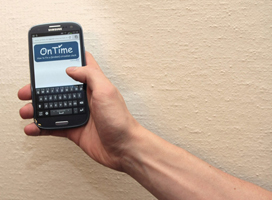
Devices
Oliver Amft (TUe)
Florian Wahl (TUe)
Within ONTIME we investigate cost-effective ubiquitous systems for long-term monitoring and feedback on the personal circadian rhythm. The project will develop a modular architecture for distributed on-body sensing and online ultra-low power information processing to analyse the relation of daily routines and circadian rhythm.
Whereas devices classically used in chronobiology merely record individual sensor modalities, such as physical activity level from the wrist, novel ubiquitous systems could enable distributed monitoring of the human circadian clock thus integrating multi-modal sensing, processing, and feedback. Such ubiquitous systems could provide continuous estimates of physiological state and contextual information in free-living individuals. Collectively capturing various context types, including user location, behaviour, physiology, and environmental state (e.g. natural/artificial lighting) is a key feature of ubiquitous systems, which cannot be assessed non-invasively (i.e., without questioning the subject) using existing techniques.

Over the past years mobile, ubiquitous systems have become widely available. We aim to utilise different devices, such as smartphones to develop ubiquitous monitoring systems that facilitate studies in free-living individuals. Among our sensing solution, the smartphone acts as an on-body hub, responsible for collecting and processing data gathered from phone-integrated sensors as well as from on-body and worn wireless sensors. Such ubiquitous sensing systems will allow study participants to roam freely, thus following their daily activities in a naturalistic ways. From the data gathered from sensors, daily routines of users can be inferred. Based on daily activity information it may be feasible to determine the effect of daily habits on the circadian clock. With the processing power of todays smartphones it is possible to sense, fuse, and evaluate data from a variety of smartphone integrated and body-worn wireless sensors directly on the phone and then send results via Internet to a central server. This approach enables a modular architecture allowing us to utilise a variety of sensing modalities.
Our work addresses the following objectives:
1. A modular, distributed and cost-efficient sensing platform for circadian clock monitoring potentially consisting of a smartphone used as on-body hub, multiple wireless sensors, and online ultra-low power signal processing and pattern recognition algorithms to derive context and activity information of its users.
2. The development of algorithms which allow to infer information about the circadian clock based on detected activity patterns. Attention will given to mental state estimation and coupling to the circadian rhythm, using physiological models of heart, electrodermal activity, and behavioural information.

